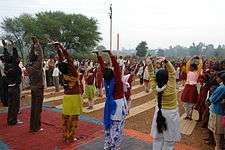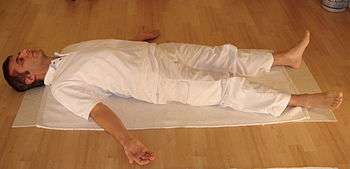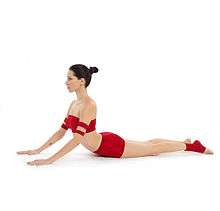Surya Namaskara



Surya Namaskara (Sanskrit: सूर्यनमस्कार, IPA: [suːrjɐ nɐmɐskɐːrɐ]; IAST: Sūrya Namaskāra) is a common sequence of asanas. Its origins lie in India where its large Hindu population worships Surya, the Hindu solar deity. This sequence of movements and asanas can be practised on varying levels of awareness, ranging from that of physical exercise in various styles, to a complete sadhana which incorporates asana, pranayama, mantra and chakra meditation. It is often the beginning vinyasa within a longer yoga series. Sūrya Namaskāra may also refer to other styles of "Salutations to the Sun". The Sun Salutation is regularly practised in many Indian schools.
History
Ancient
The Hatha Yoga Pradipika, the oldest known hatha yoga text does not mention "Surya namaskar" but mentions a sūrya-bhedana (sun-piercing) kumbhaka (II, 44 and 48–50)[2][3] while the Gheraṇḍa Saṁhitā mentions sūrya-bheda kumbhaka (58–59).[4] The oldest documented book with clear depictions of asanas is the Sritattvanidhi, though there is no mention of Surya namaskar in the text, it does describe the asanas "Sarpasana" (Bhujangasana), "Gajasana" (Adhomukh Swannasan), "Uttanasana" and series of asanas done in tandem, similar to Sūrya Namaskāra.[5].
Mysore
Incidentally the translator of the ancient Sritattvanidhi., Krishnaraja Wodeyar III, was also responsible for arranging for Sri. T. Krishnamacharya to teach yoga at Yogaśālā in Mysore sometime around 1930.[6] Sri. T. Krishnamacharya's teachings are largely responsible for the modern version of Sūrya Namaskāra as seen in modern day Ashtanga Vinyasa Yoga and the Visesha Vinyasa Sun Salutation subroutine from Vinyasa Krama Yoga,[7] as well as a host of other popular forms of yoga.[8] K. Pattabhi Jois claims to have taught exactly as he had learned from Krishnamacharya,[9] though other than personal testimony, there seems to be no other evidence as to the precise content of Krishnamacharya's teachings.[10] While Krishnamacharya's specific sources for his yoga teachings are unclear, it is said that he learned from Ramamohana Brahmachari in the Himilayan Mountains (perhaps Muktinath where his son has visited,[11] but certainly somewhere near the Gandaki River in Nepal) beginning in 1916;[12][13] however, the source of his teaching (at the Mysore Yogashala or otherwise) is not otherwise documented. Krishnamacharya's son attests to his father having developed some of his teachings himself.[14] There is the possibility that he may have been influenced by the Mysore Palace Gymnastics Tradition.[15]
Raja of Aundh
Another indication as to the origins of Sūrya Namaskāra is the 1928 Indian publication of "The Ten Point Way of Health"[16] by Raja Bhavan Rao Srinivas ("Bala Sahib"), Pant Pratinidhi of Aundh (1868–1951; Raja of Aundh 1909–1947),[17] followed by later publication in England in 1938.[18] The Raja claims to have practised the series as a child. And some sources report that only after extensive practice and analysis (and potentially modification) himself did he finally publish the book.[19] Thus, the true origin of the series remains unclear, though it has to be noted that Raja of Aundh, himself never claimed to have invented Surya Namaskar. Further he actually stressed on the ancient origins of this procedure.[20] He helped in popularising surya namaskar as a simple physical exercise for all round development of an individual in India. He introduced it in schools as a form of education and encouraged even the ordinary man to be physically fit by performing surya namaskar every day.[20][21] Still, how exactly Sūrya Namaskāra came to be included in the yogic practices of Hatha and Ashtanga Yoga remains unclear.[22]
Other references
Other sources which cite early use of Surya Namaskar are A Short History of Aryan Medical Science from 1896, which claims that in India "there are various kinds of physical exercise indoors and outdoors. But some of the Hindus set aside a portion of their daily worship for making salutations to the Sun by prostrations. This method of adoration affords them so much muscular activity that it takes to some extent the place of physical exercise".[23]
Early English publications record some ancient methods of sun salutation; however, they do not seem to be related to the modern Sūrya Namaskāra as seen in Yoga practice today. In "A Catalogue raisonnée [sic] of oriental manuscripts",[24] noted that a short book with 71 leaves with "Tricha calpa vidhi" from "Aditya Puranam" was preserved. He describes the vidhi as "Modes of rendering homage to Sun, with praise and spells; the object being health or delivery from disease". He further notes the presence of Arghya Pradana, Surya Stotaram, Aditya dvadasa namam – 12 names of the Sun according to the monthly signs of zodiac, Surya Narayana cavacham, Saurashtacshari mantram, and many other elaborate rituals as the part of the vidhi. In Page 148 of the same book he describes a shorter version called "Laghu tricha kalpa vidhi".
Historically it is widely believed in the state of Maharashtra that Shivaji Maharaj, Sage Samarth Ramdas and the Marathas have performed Sūrya Namaskāra as a physical exercise to develop able bodies.[25] This may be related to vyayama ("physical exercise" in Sanskrit) being traditionally influenced by spirituality. Many physical practices have ingrained spiritual values in them. In addition spiritual training is considered as a part of physical training from ancient times in India.
Valmiki Ramayana
Aditya Hridayam[26][27][28] is another ancient practice which involves a variation of Sūrya Namaskāra. It is a procedure of saluting The Sun, taught to Rama by Sage Agastya, before his fight with Ravana. It is described in the "Yuddha Kaanda" Canto 107 of Ramayana.
There are in total 124 names praising the Sun in the whole procedure. The names in verses 10 – 13,[26] the names in bold are the names used in the present day popular Surya Namaskar are present in these verses given below:
" Aditya, Savita, Surya, Khaga, Pushan, Gabhastiman, Suvarnasadrisa, Bhanu, Hiranyaretas, Divakara, Haridasva, Sahasrarchish, Saptasapti, Marichiman, Timironmathana, Sambhu, Twashta, Martanda, Ansuman, Hiranyagarbha, Sisira, Tapana, Bhaskara, Ravi, Agnigarbha, Aditiputra, Sankha, Sisiranasana ".
In verse 15 – 20,[26] salutations to Sun are described. An example from the 15th verse is:
नक्षत्रग्रहताराणामधिपो विश्वभावनः। तेजसामपि तेजस्वी द्वादशात्मन् नमोऽस्तु ते॥ १५॥
Nakshatra grahataaraanaam adhipo vishva bhaavanah. Tejasaamapi tejasvii dvaadashaatman namostute, verse 15
He is the lord of stars, planets and all constellations. He is the origin of everything in the universe and is the cause of the lustre of even the brilliant ones. Salutations to Thee who is the One being manifest in the twelve forms of the Sun.
Practice


- Surya Namaskara, like most asanas, is recommended to be performed on an empty stomach. Therefore some recommend a gap of at least two hours after eating and before performing the namaskara. It is generally practised in the morning before breakfast or in evening.[29]
- Shavasana is practised at the end of practice for rest.
- Pranayama is synchronised with asanas.
- Mantras can be pronounced at the start of each Surya namaskara. Bījas (seeds) or the 12 mantras specific to each asana can also be chanted while performing each asana. The 12 specific mantras, though, repeated mentally instead.
- Chakras are points-of-focus, when performing asanas.
- There are a total of 8 different asanas in the sequence of the 12 asana changes of Surya namaskara. Some asanas are repeated twice in the same cycle of a Surya Namaskara.
- In a traditional Hindu context, Surya Namaskara is performed facing in the direction of the rising (east) or setting (west) sun.
- According to the scriptures one who performs the Surya Namaskaras daily does not get poor in a thousand births.
- There are 5 ways in which breathing should be done during Surya Namaskar.
The following lists Surya Namasakar A. Other variations including Surya Namasakar B exist.
| Step | Asana | Breath | Images | Chakra | Position | Bīja | |
|---|---|---|---|---|---|---|---|
| Sanskrit | Transliteration | ||||||
| 1 | Pranamasana | exhale | |
Anahata | Heart | ॐ ह्रां | om hrāṁ |
| 2 | Hasta Uttanasana | inhale | |
Vishuddhi | Throat | ॐ ह्रीं | om hrīṁ |
| 3 | Hastapaadasana | exhale | |
Swadhisthana | Sacrum | ॐ ह्रूं | om hrūṁ |
| 4 | Aekpaadprasarnaasana (one foot back, lift head, hands often on earth ) | inhale | |
Ajna | Third eye | ॐ ह्रैं | om hraiṁ |
| 5 | Adho Mukha Svanasana / parvatasana | exhale | |
Vishuddhi | Throat | ॐ ह्रौं | om hrauṁ |
| 6 | Ashtanga Namaskara | suspend | |
Manipura | Solar plexus | ॐ ह्रः | om hraḥ |
| 7 | Bhujangasana | inhale |  |
Swadhisthana | Sacrum | ॐ ह्रां | om hrāṁ |
| 8 | Adho Mukha Svanasana | exhale | |
Vishuddhi | Throat | ॐ ह्रीं | om hrīṁ |
| 9 | Ashwa Sanchalanasana (opposite foot forward from 4, hands often on earth ) | inhale | |
Ajna | Third eye | ॐ ह्रूं | om hrūṁ |
| 10 | Uttanasana | exhale | |
Swadhisthana | Sacrum | ॐ ह्रैं | om hraiṁ |
| 11 | Hasta Uttanasana | inhale | |
Vishuddhi | Throat | ॐ ह्रौं | om hrauṁ |
| 12 | Pranamasana | exhale | |
Anahata | Heart | ॐ ह्रः | om hraḥ |
Mantras
12 Surya Namaskaras are practised per cycle.
In the table, the following first 12 mantras corresponds to the 12 asanas in Surya Namasakara and can also be chanted or repeated mentally during the performance of each corresponding asana.[30][31] They can also be pronounced at Pranamasana.
| Salutation | Sanskrit | Transliteration |
|---|---|---|
| 1 | ॐ मित्राय नमः | om mitrāya namaḥ |
| 2 | ॐ रवये नमः | om ravaye namaḥ |
| 3 | ॐ सूर्याय नमः | om sūryāya namaḥ |
| 4 | ॐ भानवे नमः | om bhānave namaḥ |
| 5 | ॐ खगाय नमः | om khagāya namaḥ |
| 6 | ॐ पूष्णे नमः | om pūṣṇe namaḥ |
| 7 | ॐ हिरण्यगर्भाय नमः | om hiraṇya garbhāya namaḥ |
| 8 | ॐ मरीचये नमः | om marīcaye namaḥ |
| 9 | ॐ आदित्याय नमः | om ādityāya namaḥ |
| 10 | ॐ सवित्रे नमः | om savitre namaḥ |
| 11 | ॐ अर्काय नमः | om arkāya namaḥ |
| 12 | ॐ भास्कराय नमः | om bhāskarāya namaḥ |
| 13 | ॐ श्रीसवितृसूर्यनारायणाय नमः | om śrīsavitṛsūryanārāyaṇāya namaḥ |
The following mantra is pronounced at the beginning of a Surya Namaskara cycle:
ॐ ध्येयः सदा सवित्र मण्डल मध्यवर्ती नारायण सरसिजा सनसन्नि विष्टः
केयूरवान मकरकुण्डलवान किरीटी हारी हिरण्मय वपुर धृतशंख चक्रः
keyūravāna makarakuṇḍalavāna kirīṭī hārī hiraṇmaya vapura dhṛtaśaṁkha cakraḥ
om dhyeyaḥ sadā savitra maṇḍala madhyavartī nārāyaṇa sarasijā sanasanni viṣṭaḥ
The following mantra is pronounced at the end of a Surya Namaskara cycle:
आदित्यस्य नमस्कारन् ये कुर्वन्ति दिने दिने
आयुः प्रज्ञा बलम् वीर्यम् तेजस्तेशान् च जायते
ādityasya namaskāran ye kurvanti dine dine
life expectancy, conscious, strength, courage and vital power shall grow.
āyuḥ prajñā balam vīryam tejasteśān ca jāyate
For those who salute the sun every day,
See also
| Wikimedia Commons has media related to Surya Namaskar. |
References
- ↑ Indian Express (4 September 2010). Destination Delhi.
- ↑ Svatmarama 15th century CE, trans. 1992.
- ↑ Swatmarama 15th century CE, trans. 1915.
- ↑ http://brihaspati.net/downloads/Gheranda_Samhita_S_C_Vasu.pdf
- ↑ Sjoman 1999.
- ↑ Sjoman 1999, p. 53.
- ↑ Ramaswami 2005, p. 213-219.
- ↑ Singleton 2012, p. 176.
- ↑ Medin 2004, p. 9.
- ↑ Sjoman 1999, p. 50.
- ↑ Medin 2004, p. 13.
- ↑ Steiner 2012, p. The Whose Who of the Ashtanga Yoga Tradition.
- ↑ Sjoman 1999, p. 51.
- ↑ Medin 2004, p. 7.
- ↑ Sjoman 1999, p. 53.
- ↑ Hall 2012, p. Balasahib's 1928 Suya Namaskar.
- ↑ S.P.Sen, Dictionary of National Biography; Institute of Historical Studies, Calcutta 1972 Vols.1–4; Institute of Historical Studies, vol 3, p.307
- ↑ Pratinidhi 1938, p. 16.
- ↑ Alter 2000, p. 95.
- 1 2 Royal India: A Descriptive and Historical Study of India's Fifteen Principal States and Their Rulers By Katherine H. Diver, Maud Diver, (year 1942)
- ↑ Alter 2000, p. 99.
- ↑ Alter 2004, p. 23.
- ↑ Simhajī 1896, p. 6.
- ↑ A Catalogue raisonnée [sic] of oriental manuscripts, Rev. William Cooke Taylor, H. Smith, (year 1860, Page 246)
- ↑ (Editor) Mujumdar 1950.
- 1 2 3 Master Murugan, Chillayah (20 October 2012). "Surya Namaskara -Puranic origins of Valmiki Ramayana". Silambam. Retrieved 31 May 2013.
- ↑ sanskrit.safire.com, Aditya Hrudayam with English translation
- ↑ Translation of Ramayana by Griffith
- ↑ ""preferable to do suryanamaskar early mornings" http://lifestyle.in.msn.com/health/article.aspx?cp-documentid=1670124
- ↑ "Surya Namaskara (Salute to the Sun) – Level 3". Yogaindailylife.org. Retrieved 7 July 2013.
- ↑ http://www.geetganga.org/suryanamaskar-mantra-सूर्यनमस्कार-मन्त्र
Sources
- Sjoman, N.E. (1999). Yoga tradition in Mysore Palace. Abhinav publications. ISBN 81-7017-389-2.
- Ramaswami, Srivatsa (2005). The Complete Book of Vinyasa Yoga. Da Capo Press. ISBN 978-1-56924-402-9.
- Simhajī, Bhagavat (1896). A Short history of Aryan Medical Science. Macmillan.
- Svatmarama, Swami; (Eng. Trans.) Becherer, Elsy; (Commentary) Rieker, Hans Ulrich (15th century CE, trans. 1992). (PDF) http://www.hermetics.org/pdf/HathaYogaPradipika.pdf. Check date values in:
|date=(help); Missing or empty|title=(help) - Swatmarama, Swami; (Trans.) Sinh, Pancham (15th century CE, trans. 1915). Allahabad http://en.wikisource.org/wiki/Hatha_Yoga_Pradipika. Check date values in:
|date=(help); Missing or empty|title=(help) - (Editor) Mujumdar, Dattatraya Chintaman (1950). Encyclopedia of Indian Physical Culture: A Comprehensive Survey of the Physical Education in India, Profusely Illustrating Various Activities of Physical Culture, Games, Exercises, Etc., as Handed Over to Us from Our Fore-fathers and Practised in India. Good Companions.
- Singleton, Mark (2010). Yoga Body: The Origins of Modern Posture Practice. Oxford University Press.
- Steiner, Ronald (2012). "AshtangaYoga.info". Retrieved 19 May 2012.
- Hall, Anthony Grimm (2012). "Balasahib's Original 1928 Suya Namaskar". Retrieved 26 May 2012.
- Pratinidhi, Shrimant Balasahib Pandit (1938). The Ten Point Way to Health. J. M. Dent and Sons Ltd. Retrieved 25 May 2012.
- Alter, Joseph S. (2000). Gandhi's Body: Sex, Diet, and the Politics of Nationalism. University of Pennsylvania Press. ISBN 978-0-812-23556-2.
- Alter, Joseph S. (2004). Yoga in Modern India: The Body between Science and Philosophy. Princeton University Press. ISBN 978-0-691-11874-1.
- Medin, R. Alexander; Summerbell, Deirdre (2004). "3 Gurus, 48 Questions: Matching interviews with SRI T.K.V. DESIKACHAR, SRI B.K.S. IYENGAR & SRI K. PATTABHI JOIS" (PDF).